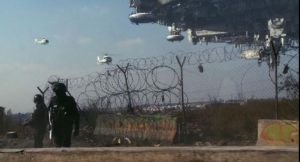
As action flicks go, District 9 excels beyond measure, but leave it to a genre film with B-movie splatter gore sensibility to create an immersive experience that generates more human pathos than a hundred overcooked dramas about the holocaust or racism. Dramas tend to be straightforward in driving their point home with a sledgehammer, while horror, sci-fi, and action remain free to entertain and take risks while the subtext creeps in to create an altogether different enterprise. Neil Blomkamp, the first-time director of District 9, does have an agenda. Even so, the film delivers jaw-dropping visuals, bone-crunching action set pieces, and kills shit with a fury that ushers it in as the best film of the year, with no likely successor. Thoughtful, impossibly ambitious, and above all fun. I have not seen a theater erupt in applause and a cacophony of elated hooting like that in years.
In the mid-1980s, a massive alien ship descends upon the Earth as the human race prepares for war with an unseen adversary that inspires no end to fear. Rather than the usual film-friendly cities, its silhouette darkens Johannesburg, which turns out to be the ideal representative human city in ways that more familiar sights never could. Jo’burg is an enormous, sprawling collection of human bustle that has been little changed over the past 150 years from the dusty mining town that existed solely due to the rich reef of gold beneath its feet. Its citizens are busy, swift-moving, and often paranoid hustlers, and no action is taken that does not involve business.
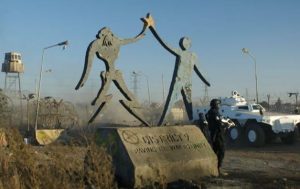
This rough but pragmatic metropolis awaits the coming threat. Rather than launching an assault, the ship simply comes to rest above the city and remains silent and unexplained for a year. Curious humans cut into the hull and find a million aliens within, starving, sick, and writhing in their own excrement in a display that inspires less pity than disgust. With the world watching, the aliens are rescued and transported to a township, though this is less a result of altruism than it is a lack of any other ideas. Fear takes a deeply cynical turn toward resentment and then exploitation as South Africa is now stuck with a million aliens in an already crowded city, with citizens angry about their diseased appearance and the tremendous expense of creating a military garrison to contain them.
The documentary-style opening appears gleaned from various news clips and camera footage that presents this as a rather serious problem with no elegant solution. The aliens are named ‘prawns’ in reference to their somewhat crustacean appearance. And like all names given to groups of beings, it becomes every bit as objectifying as kaffir, nigger, or kike. The ‘prawns’ are disgusting to look at, inspiring revulsion on top of contempt for their violent ways.
Crushed into the overcrowded tin shacks that litter the townships, they root through garbage to stay alive, are hostile to the authorities, become addicted to a protein in cat food and become pathetic junkies. They are as repulsive as the emaciated and filthy Jews in a concentration camp, or perhaps the dirty and violent blacks who packed the Bantustans during Apartheid-era South Africa (actually, they still do today). When stripping a race of their humanity, it is essential to remove their dignity first. The subtext here is not subtle, and the news footage contains whites and blacks united in their mutual hatred of these prawns. Yes, Jo’burg turns out to be the perfect cauldron of racial unease and ethnic tension for a cynical – and likely realistic – portrayal of what humanity would do when presented with yet another minority to deal with and take advantage of.
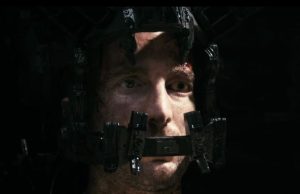
Wikus Van Der Merwe is a slavish corporate office geek promoted way beyond his limited competence via nepotism. He inspires no empathy as he heads the effort to evict and relocate the prawns to a more distant and crowded tented area that even he admits is a concentration camp. The aliens must sign a piece of paper to lend the mass eviction the appearance of legality in a sly nod towards the ridiculous array of laws that made up Apartheid. When an alien smacks Van Der Merwe’s clipboard in anger, he meekly assures the camera that it was as good as a signature. His bureaucratic drone character is backed by a military presence that executes prawns at will.
This is punctuated by a scene where a shed filled with developing young is incinerated while Wikus laughs about the ‘sound of popcorn’. The slums are run not by the government, but by violent Nigerians who are the scum of the earth. They run drugs, guns, and interspecies prostitution, while exploiting the prawns’ addiction to cat food. They also deal in alien body parts, consumed in voodoo rituals intended to grant strength. Apart from the alien thing, none of this deviates from reality – Nigerians actually do run the worst areas of Jo’burg and drive the murder and carjacking rates to obscene levels. Overall, the audience is left with no hero to root for in what appears to be a mess of urban decay and humanity at its least sympathetic.
The aliens have fused biology with technology, and their machines run on living fluid that suggests nanotechnology. They possess devastating weaponry that only they can operate (enabled by their DNA and living contact), a requirement that a corporation is working feverishly to get around. The excitement of first contact with an alien race is really a dash to unlock its secrets and build a lucrative empire off the sale of weapons and other technology. Wikus is forced to confront this when a device sprays him with fluid that infects him with alien DNA, and he begins to transform into the ‘other’ that is regarded with contempt. Forced to flee for his life, he hides in District 9, and must find a way to regain his life. A more prosaic film would have its protagonist develop a sudden identification with those he calls ‘prawns’, but his circumstances have made him no less selfish than he was before, and he is willing to throw any of the prawns under the bus for his benefit. Wikus is a unique creation in a film genre, an everyman that really is no better than any of us.
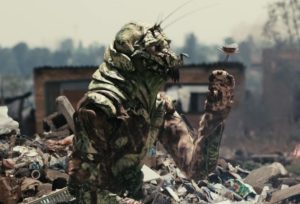
Peter Jackson and Neil Blomkamp use CGI in a way that provides essential visuals in service of a difficult and complex story, and one that does not shy away from uncomfortable themes. You are not likely to see a project further removed from deeply retarded shitfests like Transformers or GI Joe; in these films, the animation is the star and focus. In District 9, the CGI lends shading to a film with a heart that does not hesitate to show a heartless world. Far from a finger-wagging exercise that lectures the viewer, it simply presents a situation that feels, despite its unusual concept, very real in execution. At the core, the primal desire for survival and safety amidst inhuman pressure generates a poignancy that is organic to the proceedings rather than shoved down your throat in a reach for relevance.
This is what the best science fiction is capable of; using a what-if to ask big questions about ourselves. The question of the implications of humanity as well as the fluid search for identity ring throughout, and the whole affair is stewed in a distasteful stew of ethnic suspicion, cynical opportunism, and inhuman squalor. The actors are all new to the business, and strike true notes throughout. Even those characters that appear broadly drawn are based on real people.
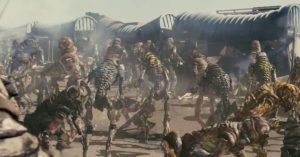
For example, the insane army captain that clearly relishes the chance to kill prawns and get paid for it is a mirror of those notorious South African soldiers who committed innumerable atrocities during the occupation of Angola and Namibia. The Nigerian drug lord channels the reptilian nature of the amoral crime bosses that run Hillbrow (a hyperdense suburb of Jo’burg) with an iron fist and stack the bodies of innocent bystanders as warnings to competitors. This is why Johannesburg was the correct choice for a setting – not just for its complex ethnic milieu, but because the world outside the comfortable confines of the west really can be this dangerous.
Lest I forget, this movie was a ball. The setup is engaging, moves quickly and efficiently to build characters you know (but may not like), and then injects them into action scenes that are furious and pulse-quickening. The excitement comes not only from the shockingly good craft of Blomkamp, but from the real and human stakes involved in the struggle. Peter Jackson’s fertile imagination bleeds through as shit goes boom and splat in scenes that rack up impressive novelty deaths that had me on my feet for the entire last third of the film, along with everyone else in my section.

A thirty-year old soccer mom type next to me was screaming KILL THAT SON OF A BITCH! The villainous types meet their collective ends in exotic fashion, and you end up cheering for, of all people, Wikus, as he enters the brawl and with the other so-called prawns brings the pain. I fucking loved this movie, its insane aspirations, boundless energy, and flawless delivery of acting, action, and effects in creating a movie that never loses sight of its human center. The final shot provides the perfect coda, with a moment of oblique optimism to counterpoint the preceding carnage. From a pile of rubbish, a soda can is shaped into a flower, echoing an art form common in the townships of Jo’burg where a delicate beauty is found amidst even wretched circumstances.
Such is the world we inhabit, and finding such cause for optimism is a rare choice to make.